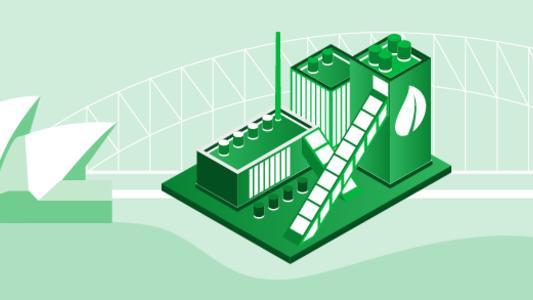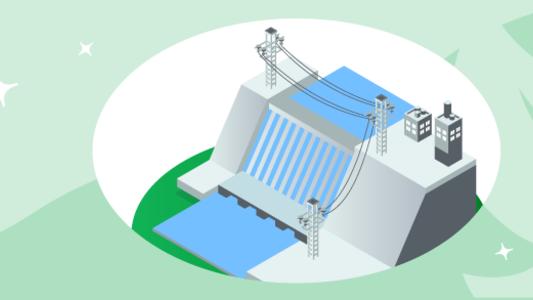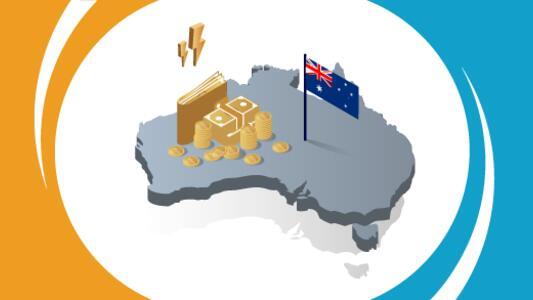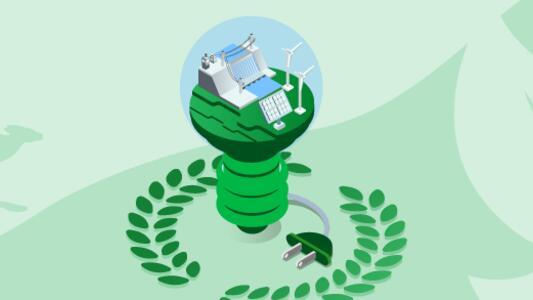Wind Energy, Wind Turbines, and Wind Power in Australia
Wind power is an important part of renewable energy generation in Australia, accounting for over 35% of all renewable energy generation in the country. This energy generation method, which involves capturing the power of the wind with turbines, and turning it into electricity with generators, is the biggest (and growing) renewable energy source in the country. Like all energy generation methods wind energy is not without its downsides, but to find out all the pros and cons of wind power, how wind power is generated & how wind turbines work, and the future of wind energy in Australia, continue reading below.
What is wind energy? How do wind turbines work?
The wind has been used as a source of energy for thousands of years. From sailing boats, to windmills crushing grain and creating paper, wind power has always been an important part of human history. While the technology used to generate wind power has changed and evolved over the years, the idea of wind being used in energy generation remains largely the same.
In short, wind power is the concept of using the wind to generate energy. Today, that primarily means electricity generation. While the wind is blowing, it spins large wind turbines, which look like massive, modern-day windmills. These wind turbines, in turn, rotate an electricity generator which is then used to power the electricity grid, homes, businesses, and/or communities.
Different types of wind turbines
Wind turbines are used to generate electricity using the wind. There are two main types of wind turbines, which can vary in size depending on where they are located and how they will be used.
There are two types of wind turbines:
Horizontal-axis turbines: What we usually picture what we imagine on large wind farms. Horizontal-axis turbines usually have three blades, and the top of the turbine rotates to ensure it’s consistently facing the wind.
Vertical-axis turbines: Vertical-axis turbines can spin in every direction the wind is blowing, and don’t need to rotate or pivot their blades to face the direction of the wind in order to generate energy.
Depending on the location and use of the wind turbines, they can be scaled up or down to fit the needs of the community or area they are serving. This includes:
Off-shore wind turbines: The largest type of wind turbines, which are placed in large bodies of water such as oceans or lakes, and are able to capture the powerful ocean wind to generate huge amounts of energy.
Utility wind turbines: Land-based turbines and what we usually imagine when we think of wind farms. These wind turbines are often grouped together to generate large amounts of electricity on open fields or farms for the electric grid.
Small-scale wind turbines: These are typically wind turbines, under 100kWh, used for residential, agricultural, or small-scale commercial energy generation. Small-scale wind turbines are popular for remote and off-grid locations where electricity might be unreliable or nonexistent.
Need Energy Advice ?
Selectra's Energy Experts are Available To Help You Free of Charge
(Free Selectra Service - Currently open)
Wind energy pros and cons
Despite the fact that wind energy has been harnessed, in some capacity, for thousands of years, modern wind energy generation is not without its faults. The biggest arguments against wind power, and even to some extent hydroelectric power, is that while wind energy is a renewable resource, it often requires huge amounts of cleared land to support the turbines which, in turn, disrupt local wildlife. This, in addition to the noise pollution caused by the spinning turbines, and general eyesore they create, are often cited as reasons why wind farms should not be built.
However, wind energy is clean and renewable and, once built, requires very little additional upkeep costs. Wind energy and wind farms are also great for those with huge amounts of land, such as farmers, who can rent or lease their property for wind turbine development which brings in more money to the local economy.
| Pros of wind energy | Cons of wind energy |
|---|---|
|
|
Wind farms in Australia
Wind power is the largest renewable energy source in Australia, and for good reason. Australia as a whole is well-equipped for wind energy particularly along the southern coastline thanks to the westerly winds (also known as the Roaring Forties) found in the Southern Hemisphere.
Since the 1980’s, wind power generation has grown immensely in Australia and is currently the largest renewable energy source in the country. As of May 2025, wind energy has accounted for 13.4% of all electricity generated in Australia and makes up 35% of all renewable energy sources.
Clean Energy Council Reports 2020-2025
By the end of 2024 there was, according to the Australian Clean Energy Council:
- 6,279MW of installed wind power capacity
- An additional 21,845MW proposed as of February 2020
- 101 wind farms in Australia with wind turbines ranging from 1.5 to 3 MW
- 30 more wind farm projects with a combined generating capacity of 5,500MW committed to being build by 2024/25
| Number of projects | Number of turbines | Total MW | Percentage of wind generation by state | |
|---|---|---|---|---|
| New South Wales | 15 | 527 | 1,256 | 22.6% |
| Victoria | 29 | 834 | 1,922 | 27.8% |
| Queensland | 4 | 71 | 238 | 3.2% |
| South Australia | 22 | 786 | 1,927 | 29.2% |
| Western Australia | 22 | 345 | 621 | 11.0% |
| Tasmania | 8 | 126 | 314 | 6.3% |
Source: Source: Clean Energy Australia Report 2024
The largest wind farm in Australia, known as Coopers Gap Wind Farm, is owned by AGL and located north of Brisbane. While currently in the process of being built, it began generating electricity in the summer of 2019 and once completed will produce about 1,510,00MWh of energy per year which, AGL says, will power approximately 260,000 Australian homes.
Many wind farms are Green Power accredited, and are producers for companies that have Green Power plans, in which their customers commit them to purchase and use more renewable energy.
Residential wind turbines in Australia: Is small-scale wind energy viable?
Solar energy is the star of small-scale renewable energy generation, easily able to be scaled up or down and can carry out multiple functions such as heating your water or heating your pool using just the sun's energy.
However, is residential wind power just as viable?
The short answer is that while small-scale wind turbines for off-grid energy generation might be possible, it isn’t always practical.
Many farms, remote communities, and off-grid homes have smaller wind power generators with residential turbines, but it is often the case that they just can’t generate all the electricity needed. For small, residential wind turbines a consistent (non-erratic) wind speed of around 7-8 meters per second on average, is recommended in order for these turbines to be a worthwhile investment.
Before purchasing and installing residential wind turbines, you first need to measure the speed of the wind on your property for a full 12 months using an anemometer to see if residential turbines will work well on your property.
Residential wind turbines can cost anywhere from $7,000 to over $20,00 per turbine, and it’s important to check local council regulations, such as height restrictions, which might hinder your ability to install wind turbines on your property.
How tall do my residential wind turbines need to be? According to Your Home by the Australian Government, the bottom of the rotor or blades on a residential wind system should be at least 10m above the tallest obstruction within 150 meters. If this includes trees, the mature tree height over a 20-30 year period should be considered, not the current height of the tree.
The future of wind power in Australia
Wind energy is on the rise in Australia the the government and private sector push toward reaching Australia's renewable energy target. As stated, several dozen wind farm projects with a combined total capacity of 5,500MW are currently in the works. In addition, the cost of wind energy is continuing to fall. According to the Australia Renewable Energy Agency (ARENA),
The cost of utility-scale wind energy in Australia is expected to continue falling, with new wind farms expected to deliver electricity at around $50-65/MWh in 2020 and below $50/MWh in 2030.
The future of wind power in Australia is on the upswing. While still lagging behind other major countries (Denmark, for example, gets over 40% of its total electricity from wind energy as compared to Australia's 8%), there are over 90 total projects in the works for the future including the 30 wind farms set to be completed by 2021. The Australian Clean Energy Council Project Tracker, as of 2025, predicts these wind energy projects will bring 11,007 MW of new renewable energy capacity to the country and create 13,567 direct jobs.
Need Energy Advice ?
Selectra's Energy Experts are Available to Help You Free of Charge
(Free Selectra Service - Currently open)
Wind energy and wind turbine FAQ
How much wind energy is used in Australia?
Wind energy is one of the biggest sources of renewable energy in Australia. In September 2024, wind energy accounted for 13.4% of total electricity generated in the country, and 35.4% of total renewable energy.
Are residential wind turbines worth it?
A typical home uses just under 11,000kWh of electricity per year. In order for residential wind turbines to be worth it, you would need a wind turbine rated between 5-15kW in order to make any significant contribution to your energy generation and consumption. In addition, many residential properties aren’t suitable for residential wind turbines. If you’re interested in small-scale renewable energy, solar panels are a much more popular choice with many solar rebates available through the government and energy retailers, such as the feed-in tariff program.
How much does a wind turbine cost in Australia?
Depending on the turbine capacity, tower type, and location, a wind turbine will set you back anywhere between $7,000 and $20,000. This cost is comparable to a full solar PV system with included battery storage (approximately $10,000-$15,000), but far more than a basic solar system with panels and inverter (between $3,000 - $10,000 depending on size and brand).
How efficient is wind energy?
The average wind turbine has an efficiency between 35% and 45%, with the maximum theoretical limit of wind power efficiency at 59.6% according to the Laws of Physics outlined by the Betz Limit which was researched by Marisa Blackwood from the University of South Florida.
Do wind turbines actually harm birds?
It’s important to note that, as far as birds and bats are concerned, wind turbines are not the most deadly threat to these flying animals. As well, the actual number of birds and bats lost to windmills is not well studied, and varies greatly depending on location with the US giving an estimated 150,000 to 200,000 per year. Studies have found that by painting wind turbine blades black, bird fatalities can be reduced by over 70%.
More about Renewable

Green Loans for Healthcare Providers: Save on Solar, EVs & Energy

Biomass Energy and Biogas in Australia

Hydroelectricity & Hydropower in Australia

Green Gas: What Is It and Can You Use It at Home?

Green Energy: What It Is and Why It Matters

Smart Lighting Systems in Australia
Click below to find a better deal for your home!


